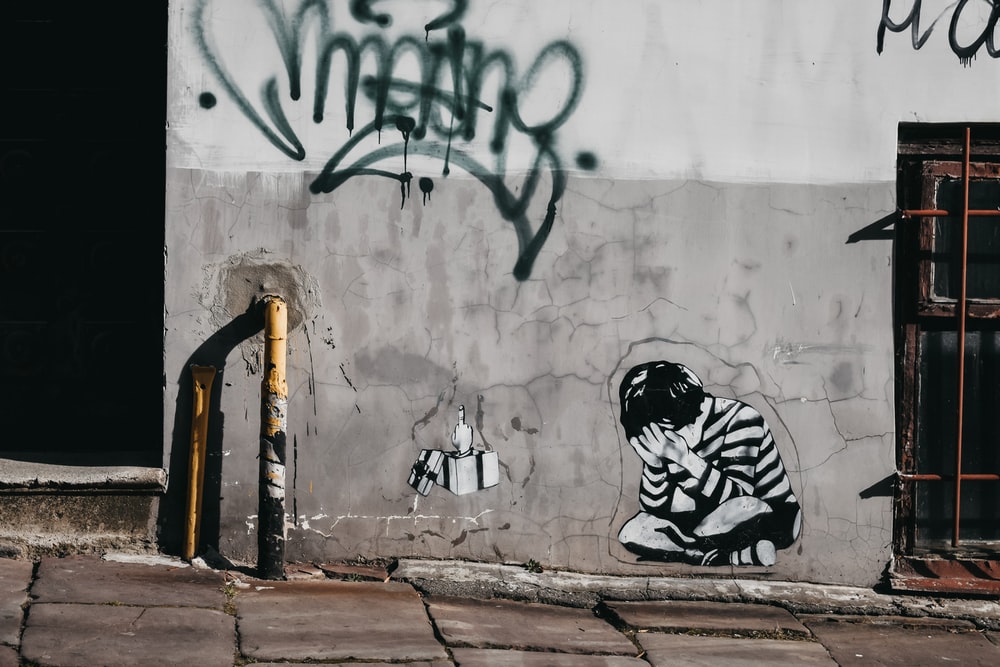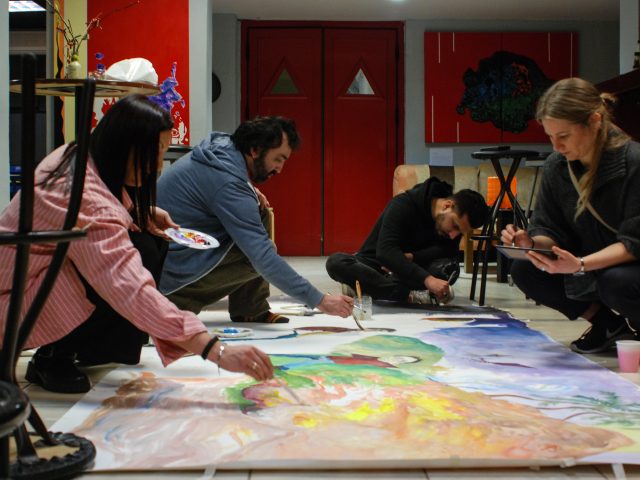By Nicole Petalidou, Expert on GBV and social protection
April 2020
Introduction
Gender Based Violence (GBV)((United Nations. (1993, March 11). Men, Boys Must Speak Out, Take Action to End Gender-Based Violence, Delegates Tell Commission on Status of Women. Retrieved from http://www.un.org/press/en/2013/wom1949.doc.htm)) or Sexual and Gender Based Violence (SGBV)((United Nations High Commissioner for Refugees. (2016). UNHCR Age, Gender and Diversity Accountability Report 2015. Retrieved from http://www.unhcr.org/5769092c7.pdf)), represents violence that is often directed against women, because they are women, and which disproportionately therefore affects women. This can take many forms such as sexual violence, sexual exploitation, domestic violence, female genital mutilation (FGM), and forced marriage. Some of these forms of violence may particularly affect children, such as FGM, forced marriage and sexual exploitation, and children are also impacted by living with domestic violence. Whilst some men may also be affected as victims, the underlying social norms which are being invoked during such violence are gendered in the nature of the power they represent and perpetuate((Council of Europe. (2011). Historical background. Istanbul Convention – Action against violence against women and domestic violence. Retrieved from http://www.coe.int/en/web/istanbul-convention/historical-background)). This is true for victims as well as perpetrators.
Violence against men constitutes a crime that goes often unheard, unseen, and unspoken. It is important to also include men in gender equality by recognizing them as victims of violence and to acknowledge the possible positive impact to be initiated from the prevention of this crime, including of relevant research((Frunse, T., Tobi, S.E., Mohammad, S. (2019, October 24). Addressing Sexual Violence Against the Male Gender: A Legal Perspective. CAJPHR – Centre for African Justice Peace and Human Rights. Retrieved from http://centreforafricanjustice.org/addressing-sexual-violence-against-the-male-gender-a-legal-perspective/)). Numerous causes lead to under-reporting and a widespread victimization((Frunse, T., Tobi, S.E., Mohammad, S. (2019, October 24). Addressing Sexual Violence Against the Male Gender: A Legal Perspective. CAJPHR – Centre for African Justice Peace and Human Rights. Retrieved from http://centreforafricanjustice.org/addressing-sexual-violence-against-the-male-gender-a-legal-perspective/)). International criminal law has developed to be able to better deal with GBV; however more attention and collective effort is needed to bridge gaps arising in practice as we bring justice to the countless male victims of violence.
When designing effective strategies, it is crucial to keep in mind that GBV is linked to gender-based power inequalities. Increase in gender equality and transformation of gender norms, are two effective ways to prevent GBV. Prevention strategies should entail a shift from the term ‘victims’ to the term ‘survivors’ with a focus on empowerment and efforts to incorporate men and boys in any intervention((SIDA. (2015). Preventing and Responding to Gender-Based Violence: Expressions and Strategies (Gender Toolbox Art.no. SIDA61848en). SIDA. Retrieved from http://www.sida.se/contentassets/18786cc0bfae45a58b07bebf0aa634e3/preventing-and-responding-to-gender-based-violence.pdf)). Equally important is the strengthening of the legal and policy framework, as well as the bridging the gap between law and practice. Also core elements of an effective strategy are efforts that give an end to the impunity for GBV((Kara Universal. (2019, June 25). Gender-Based Violence. Retrieved from http://www.karauniversal.org/post/blog-gender-based-violence)), while responding to survivors, in accordance to their rights to protection and access to services, including shelters and health sector services.
GBV Against Men
GBV is the most extreme expression of unequal gender relations in society – “It is, first and foremost, a violation of human rights and a global health issue that cuts across boundaries of economic wealth, culture, religion, age, and sexual orientation.”((SIDA. (2015). Preventing and Responding to Gender-Based Violence: Expressions and Strategies (Gender Toolbox Art.no. SIDA61848en). SIDA. Retrieved from http://www.sida.se/contentassets/18786cc0bfae45a58b07bebf0aa634e3/preventing-and-responding-to-gender-based-violence.pdf)) While GBV is disproportionally affecting women and girls, it also affects men and boys. Wherever it occurs, it is a major obstacle for the achievement of gender justice, it poses a serious threat to democracy, public health and is a critical barrier to setting foundations for sustainable evolution, economic growth and peace.
Male refugees, of any age, can be subjects to GBV((Syrri, D. (2012). Considering victims of rape and war. Retrieved from http://blogs.fco.gov.uk/artemispapakostouli/2012/12/18/preventing-sexual-violence-in-conflict-guest-blog-3/)). Survivors have various health, psychosocial, legal, and safety needs, but often find it hard to discuss their experience and access the support they need. If men and boys are not safe, they cannot be full citizens nor fully participate in the affairs of their own society((Dolan, C. (2014). Into the Mainstream: Addressing Sexual Violence Against Men and Boys in Conflict (Briefing Paper). London: Refugee Law Project. Retrieved from http://reliefweb.int/report/world/mainstream-addressing-sexual-violence-against-men-and-boys-conflict)).
According to Atiba-Davies, Head of the Gender and Children UNIT (GCU) in the Office of the Prosecutor at the International Criminal Court, and a study conducted by the Refugee Law Project of Uganda in partnership with John Hopkins, 13.4% of the 447 male refugees (aged between 18-78 from a selected settlement in Western Uganda), had experienced some form of sexual violence, including rape, anal penetration, oral sex, forced sterilization and genital torture. Recent research has shown that 1 in 6 men have been sexually abused or assaulted during their childhood or as adults in conflict and peacetime. These data demonstrate that GBV is not an issue experienced only by women, but also by men. In many jurisdictions, outdated national criminal law systems are rarely gender-neutral and thus fail to provide an option for legal recourse((Frunse, T., Tobi, S.E., Mohammad, S. (2019, October 24). Addressing Sexual Violence Against the Male Gender: A Legal Perspective. CAJPHR – Centre for African Justice Peace and Human Rights. Retrieved from http://centreforafricanjustice.org/addressing-sexual-violence-against-the-male-gender-a-legal-perspective/)).
According to international human rights law, discrimination regarding the full enjoyment of all human rights, including sexual rights, sexual orientation, and gender identity, is absolutely prohibited. On the state level, meeting human rights obligations requires efforts to be made towards the transformation of the social and cultural norms, while regulating power relations between women and men and attitudes on masculinity. Gender equality is achieved when women and men, of any age, enjoy “equal rights, life prospects and opportunities, and the power to shape their own lives and contribute to society”((Ministry of Foreign Affairs Sweden. (2010). On Equal Footing – Policy for Gender Equality and the Right and Role of Women in Sweden’s International Development Cooperation 2010-2015 (Ref.no. UD 10.062). Västerås. Retrieved from http://www.government.se/49b74d/contentassets/f8954ef446a54d83bbcecfbf5fb61fd6/on-equal-footing-policy-for-gender-equality-and-the-rights-and-role-of-women-in-swedens-international-development-cooperation-2010-2015)). On the opposite, gender inequality, unequal power relations and discrimination based on gender constitute the root of gender-based violence((Kara Universal (n.d.). Gender Justice – Ending violence against girls & women requires the sustained efforts of all. Retrieved from http://www.karauniversal.org/programs-gender-justice)).
Multiple incidents of violence may occur throughout a person’s life cycle, from the prenatal period through childhood to adulthood and old age((Ellsberg, M.C., & Heise, L. (2005). Researching violence against women: a practical guide for researcher and activists. Washington DC., United States: World Health Organization and Program for Appropriate Technology in Health (PATH). Retrieved from http://www.path.org/publications/files/GBV_rvaw_complete.pdf)). Approaching Examining GBV according to age helps us understand the continuum of violence and its cumulative impact in terms of physical and mental health damages for boys and men, while ‘mild’ and severe forms of violence consist a part of the same continuum((Kelly, L. (1991). Surviving Sexual Violence (1st Edition). Polity Press.)). While the most severe forms of violence are indeed harmful, the everyday presence of violence throughout a person’s life can be even worse.
International research recognizes the significant impact that gender-based violence has on individual health and wellbeing, whether as victims((WHO. (2014). Violence against women. Intimate partner and sexual violence against women (Fact sheet). World Health Organization. Retrieved from http://apps.who.int/iris/bitstream/handle/10665/112325/WHO_RHR_14.11_eng.pdf)) or perpetrators((Hester, M., Ferrari, G., Jones, S.K., et.al. (2015), Occurrence and impact of negative behaviour including domestic violence and abuse, in men attending UK primary care health clinics: a cross-sectional survey. BMJ Open, 5:e007141. http://doi.org/10.1136/bmjopen-2014-007141)), or communities as a whole. The EU Guidelines for the Promotion and Protection of the Rights of the Child denounce that the repercussions of violence against children((European Commission. (2017). EU Guidelines on the Promotion and Protection of Rights Child (2017). Leave no child behind (Guideline). Retrieved from http://ec.europa.eu/anti-trafficking/eu-policy/guidelines-promotion-and-protection-rights-child-2017_en)) are grave and damaging. The impact of the violence has consequences in their present lives and affects their future expectations and opportunities. To minimize the impact of previous experiences of violence there is a need to develop gender sensitive preventative services and improve those services which already exist.
GBV occurs in homes, schools, workplaces, detention centers, but also in public places. Sometimes is random, but often repeated and systematic, particularly when the perpetrator knows the victim. While GBV occurs regardless of the economic wealth, culture, religion, sexual orientation and age, some groups are particularly vulnerable. These are, for example, men in war and conflict zones, refugee and migrant men, LGBTI persons, men in prostitution, men with disabilities((SIDA. (2015). Preventing and Responding to Gender-Based Violence: Expressions and Strategies (Gender Toolbox Art.no. SIDA61848en). SIDA. Retrieved from http://www.sida.se/contentassets/18786cc0bfae45a58b07bebf0aa634e3/preventing-and-responding-to-gender-based-violence.pdf)).
There may be difficulties for men in relation to rapidly shifting ideas of appropriate masculinities during and after their migration journeys. Collisions exist between different gender norms, expectations and masculinities in home and host countries. It has been evident that there are variations in attitudes towards gender-based violence, specifically violence against women and in the family, across societies which are culturally different (e.g. Farahani 2008). Differences in culture, religion, ethnic origin, national boundaries and geographical region play a significant part in the perception of, and attitudes towards, gender-based violence((Nayak, M.B., Byrne, C.A., Martin, M.K. & Abraham, A.G. (2003). Attitudes Towards Violence Against Women: A Cross-Nation Study. Sex Roles, 46(7), 333-342. http://doi.org/10.1023/A:1025108103617)),((Rianon, N.J. & Shelton, A.J. (2003). Perception of Spousal Abuse Expressed by Married Bangladeshi Immigrant Women in Houston, Texas, U.S.A. Journal of Immigrant Health, 5(1), 37-44. http://doi.org/10.1023/A:1021052212981)),((Macey, M. (1999). Class, gender and religious influences on changing patterns of Pakistani Muslim male violence in Bradford. Ethnic and Racial Studies, 22(5), 845-866. http://doi.org/10.1080/014198799329288)). There are different intersecting identities((Aghtaie, N. (2016). Iranian Women’s Perspectives on Violence against Women in Iran and the UK. Iranian Studies, 49(4), 593-611. http://doi.org/10.1080/00210862.2015.1017970)) which can constrain the way that men identify with different masculinities((Connell, R.W. (2005). Masculinities. Polity Press.)),((Hearn, J. (1998). The Violences of Men. How Men Talk About and How Agencies Respond to Men’s Violence to Women. SAGE Publications.)), while migration processes and experiences collide with these social norms to change perceptions and experiences. Additionally, migration can create conflict between different ways of knowing in relation to gender-based violence, for example regarding views about relationships, family, children and youth, women, sexual exploitation, and masculinities.
The prevailing male stereotype in most societies is to be emotionally and physically strong. It is also important to recognize that men and boys are vulnerable, and that violent behavior can be rooted in a difficult personal history. Examples include, being beaten as boys, heavy responsibility for earning income to support families, including child labor, being tortured or witnessing torture during conflict situations, being a perpetrator as a child soldier, or managing the transition from a military to civilian life in disarmament and demobilization processes. These examples do not constitute reasons to excuse violent behavior, but they often need to be worked on through psychosocial counselling.
Male Violence Prevention
What could be done in the context of migration and forced movement to improve the health and well-being of victims and survivors through greater individual awareness of handling emotions and building social relations, gender equality, women and children rights? There is work currently taking place in European countries, for example Norway, which seeks to engage new migrants in discussions about gender and gender based violence((ATV. (2016). There are alternatives to violence. Retrieved from http://atv-stiftelsen.no/english/)), and across a number of European countries, where there are attempts to identify victims of gender-based violence and provide protection and prevention((FRA. (2016) Fundamental Rights Report 2016. European Union Agency for Fundamental Rights. Retrieved from http://fra.europa.eu/sites/default/files/fra_uploads/fra-2016-fundamental-rights-report-2016-2_en.pdf)).
As humanitarians, we are guided by humanitarian principles including impartiality, meaning that aid should be provided according to needs((Barbelet, V. (2014, June 23). Male gender-based violence: a silent crisis. ODI. Retrieved from http://www.odi.org/blogs/8502-male-gender-based-violence-silent-crisis)). More scholarly research and international discussion is required to fully understand the complex dynamics and establish a coherent analysis of male-targeted violence((Frunse, T., Tobi, S.E., Mohammad, S. (2019, October 24). Addressing Sexual Violence Against the Male Gender: A Legal Perspective. CAJPHR – Centre for African Justice Peace and Human Rights. Retrieved from http://centreforafricanjustice.org/addressing-sexual-violence-against-the-male-gender-a-legal-perspective/)). Due to a substantial lack of accurate statistics of violence instances against men and boys, the full extent of the problem cannot be measured.
Many male victims of violence are afraid to report that they were violated, to protect their masculinity as well as due to fear of repressive laws. In many cultures, men are presumed to be the dominant gender and protector of the family. Thus, a man having to report that he was raped or that he experienced any other form of violence would detriment the stereotypical role of him within society. The main reason for many male victims to choose not to report their victimization is because they internalize their feelings of shame and fear of societal stigmatization, the possibility of not being believed and the fear that victimization will recur((Frunse, T., Tobi, S.E., Mohammad, S. (2019, October 24). Addressing Sexual Violence Against the Male Gender: A Legal Perspective. CAJPHR – Centre for African Justice Peace and Human Rights. Retrieved from http://centreforafricanjustice.org/addressing-sexual-violence-against-the-male-gender-a-legal-perspective/)). Secondly, there is gender assumption, presuming women are victims and men are the perpetrators, mainly because of the idea that men are invulnerable and the ones in control. Therefore, when a man reports for example sexual victimization, instead of being treated the same as a female victim, there is an additional assumption that he was engaging in homosexual acts and that he ‘wanted it’, bypassing the premise that he is a victim. Common coping mechanisms used by victims to avoid and reduce feelings of vulnerability include drinking alcohol, taking drugs, sex, violence, engaging in arguments with other men, and not talking about the problems. To give a clearer perspective of perceptions surrounding violence, to list the concept of what gender entails with myths and facts((Frunse, T., Tobi, S.E., Mohammad, S. (2019, October 24). Addressing Sexual Violence Against the Male Gender: A Legal Perspective. CAJPHR – Centre for African Justice Peace and Human Rights. Retrieved from http://centreforafricanjustice.org/addressing-sexual-violence-against-the-male-gender-a-legal-perspective/)).
Table 1: Myths and facts about gender
| Myths/Perceptions | Facts |
| Gender is about women. | Gender includes men and women, gender and sexual diversity. |
| Gender is a concept that does not fit in any Culture. | Gender is constructed in cultures all over the world. |
| Gender is for NGO’S working with women on social issues. | Gender is a characteristic of people, communities, sectors, society. |
Source: Frunse, T., Tobi, S.E., Mohammad, S. (2019, October 24). Addressing Sexual Violence Against the Male Gender: A Legal Perspective. CAJPHR – Centre for African Justice Peace and Human Rights. http://centreforafricanjustice.org/addressing-sexual-violence-against-the-male-gender-a-legal-perspective/
Overall Points
- To prevent GBV and to protect and bring justice to survivors, an interconnected overarching strategy: preventing, strengthening legal and policy frameworks, and improving response services for survivors.
- Facilitate processes for GBV survivors to empower themselves to achieve economic independence and sustainable livelihoods
- Strengthen the capacity of front-line workers to prevent GBV and provide psychosocial and legal support to survivors.
- Integrating men into service provision is important in successfully addressing GBV. Often those who display a violent and aggressive behavior have a difficult history and may have been victims of violence themselves. Working with male perpetrators requires a separate approach, in different premises with male staff, who have specialized training and attitudes and skills for counselling violent men. Boys require specialized attention in protection and psychosocial support services, whether they are victims or witnesses of GBV, to ensure that they do not become future perpetrators.
- National campaigns on preventing GBV and questioning masculine stereotypes can make a crucial contribution to changing power relations between men and women. They need to be carefully crafted, considering cultural and local contexts.
- The humanitarian programs need to develop positions and approaches on how to deal with GBV linked to individuals of different sexual orientation.
Preventing GBV is a Key Priority
Rather than disconnecting and treating GBV as a separate and isolated problem, GBV has to be situated in the context of gender inequalities, so that prevention strategies entail:
- Recognising and addressing men’s and boys’ vulnerabilities and needs in relation to GBV and working towards transformed norms around gender relations and masculinity. Such an approach acknowledges that men and boys are also restricted by expectations linked to masculinity and can also be victims of violence. A failure to recognise and address this can contribute to the perpetuation of cycles of GBV.
- A shift in focus from considering men and boys as victims, to seeing them as survivors and agents of change. Efforts to increase men’s economic empowerment, that enhances men’s bargaining power and ability to leave abusive relationships. This includes strengthening men’s entrepreneurship and employment opportunities.
Strengthening Legal and Policy Frameworks
The States have the primary responsibility for ending GBV. Strengthening the legal and policy framework forms an important part of both prevention and response to GBV, while enabling provision of justice for survivors, legal frameworks and punishments, shape norms in society and might work as deterrents((SIDA. (2015). Preventing and Responding to Gender-Based Violence: Expressions and Strategies (Gender Toolbox Art.no. SIDA61848en). SIDA. Retrieved from http://www.sida.se/contentassets/18786cc0bfae45a58b07bebf0aa634e3/preventing-and-responding-to-gender-based-violence.pdf)).
- There is a need to improve existing legislation indirectly linked to GBV. Hence, strategies to improve legislation should not be pointed directly on laws against GVB but take into account and strive for improved legislation in other areas as well.
- While solid legislation acknowledging the rights of GBV survivors is a prerequisite, a major obstacle often lies in the implementation of such frameworks. For this reason, emphasis should be on bridging the gap between law and practice through the strengthening of certain mechanisms that will follow up and evaluate the implementation of laws addressing prevention and response to GBV.
- Systematic failures of police, justice personnel and armies put men and boys at risk of violence and prevent access to justice. Perpetrators of GBV must be held accountable under national and international law. Yet, attempting to reduce GBV by a simple focus on prosecuting offenders may not lead quickly to the desired outcomes. There is a need to recognize the limitations of convictions as prevention (through deterrence) and combine legal actions with so called secondary prevention efforts addressing social and psychological driving forces, particularly in post-conflict settings.
Improving Response Services for Survivors
In the immediate term, the effects of GBV to be tackled promptly. Survivors have rights to protection and access to services.
- Services must be based upon survivors’ needs and safety. Although the state is responsible for the safety of survivors, it is important that not only the state, but also humanitarian organizations are provided with resources to give support. They often have a deep knowledge and long experience of support and service to survivors of gender-based violence. Services must be effectively coordinated in development and humanitarian contexts and include:
- Health sector response to GBV including reproductive health, medical and psychosocial support.
- State run shelters and counselling centers in order to provide safe place to male survivors of GBV. Furthermore, such shelters could be run by independent actors, such as LGBTI organizations.
- Adequate police and justice response including legal aid to survivors.
- Economic services to aid the financial stabilization of the GBV victims.
- Provided services should be under a holistic approach (e.g. medical, psychosocial and legal support) to help both survivors and perpetrators of GBV to avoid further violence. If a survivor does not have the personal strength, because of traumas and stress caused by GBV, he may not be able to pursue justice. Services must also reach out to perpetrators of violence, the so-called secondary prevention, to decrease future perpetration.





